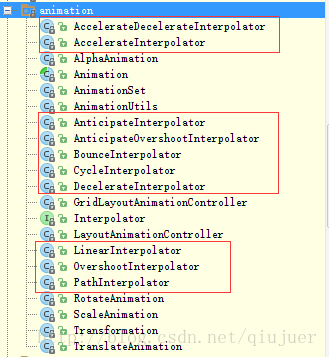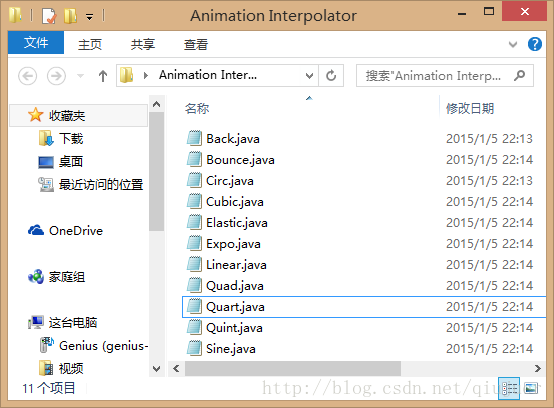========================================================
作者:qiujuer
博客:blog.csdn.net/qiujuer
网站:www.qiujuer.net
开源库:Genius-Android
转载请注明出处:http://my.oschina.net/u/1377710/blog/364668
========================================================
序
- 一个好的动画一定是用心做出来的,何为用心?其中一点我认为定义适当的 Interpolator 就是一种用心的表现;这点在 google material design 中尤为明显。
- 一个好的动画一定要符合实际,一句老的话就是:石头下落一定要受重力才优雅,不然一颗石头像羽毛一样在风中还飘啊飘的那就不行了。
介绍
Interpolator 是个什么东西?
说到 Interpolator 啊,这个要从3年前说起,话说当年谷歌、诺基亚、Qiujuer 三分天下.... 哈哈,开个玩笑~
Interpolator 这个时间插值类,其主要使用在动画中,其作用主要是控制目标变量的变化值进行对应的变化。
你可以这么理解,现在小明去买酱油,规定时间是1个小时到达,里程是1公里;现在小明心里唯恐无法达到,所以先跑起来了,但因为体力消耗所以逐渐的慢下来了;然后成功到达。这样的一个过程中把小明逐渐慢下来的这个过程抽象出来也就是 Interpolator 的工作;当然 Interpolator 也可以控制小明先慢慢热身然后越跑越快最后达到。
这些都是 Interpolator 能完成的工作,同样 Interpolator 还能控制一个弹球掉在地上弹起来逐渐降低的过程,这些都是可以控制的。
Interpolator 的原理?
public interface Interpolator extends TimeInterpolator {
}/**
* A time interpolator defines the rate of change of an animation. This allows animations
* to have non-linear motion, such as acceleration and deceleration.
*/
public interface TimeInterpolator {
/**
* Maps a value representing the elapsed fraction of an animation to a value that represents
* the interpolated fraction. This interpolated value is then multiplied by the change in
* value of an animation to derive the animated value at the current elapsed animation time.
*
* @param input A value between 0 and 1.0 indicating our current point
* in the animation where 0 represents the start and 1.0 represents
* the end
* @return The interpolation value. This value can be more than 1.0 for
* interpolators which overshoot their targets, or less than 0 for
* interpolators that undershoot their targets.
*/
float getInterpolation(float input);
}在这个方法中,传入的值是一个0.0~1.0的值,返回值可以小于0.0也可以大于1.0。
你可以这么理解:在Animation中时间是正常的走的,你设置了200ms,现在走到了100ms了,那么按照线性来说现在应该是走了一半的路程也就是0.5;现在就把这0.5传递给Interpolator 让 Interpolator 告诉我走到一半时间的时候此时小明在哪里;这也就是 Interpolator 的原理。
常用类
哎呀我的天天啊,访问不了谷歌就是麻烦,只能从源码截图了:

Android 官方提供的就是这么十种,是9种还是10种啊,没有数错吧。分别是:
- AccelerateDecelerateInterpolator 在动画开始与结束的地方速率改变比较慢,在中间的时候加速
- AccelerateInterpolator 在动画开始的地方速率改变比较慢,然后开始加速
- AnticipateInterpolator 开始的时候向后然后向前甩
- AnticipateOvershootInterpolator 开始的时候向后然后向前甩一定值后返回最后的值
- BounceInterpolator 动画结束的时候弹起
- CycleInterpolator 动画循环播放特定的次数,速率改变沿着正弦曲线
- DecelerateInterpolator 在动画开始的地方快然后慢
- LinearInterpolator 以常量速率改变
- OvershootInterpolator 向前甩一定值后再回到原来位置
- PathInterpolator 这个是新增的我说原来怎么记得是9个,这个顾名思义就是可以定义路径坐标,然后可以按照路径坐标来跑动;注意其坐标并不是 XY,而是单方向,也就是我可以从0~1,然后弹回0.5 然后又弹到0.7 有到0.3,直到最后时间结束。(这个后面单独说说)
源码
这里说几个简单的源码
LinearInterpolator
@HasNativeInterpolator
public class LinearInterpolator implements Interpolator, NativeInterpolatorFactory {
public LinearInterpolator() {
}
public LinearInterpolator(Context context, AttributeSet attrs) {
}
public float getInterpolation(float input) {
return input;
}
/** @hide */
@Override
public long createNativeInterpolator() {
return NativeInterpolatorFactoryHelper.createLinearInterpolator();
}
}DecelerateInterpolator
public class DecelerateInterpolator implements Interpolator, NativeInterpolatorFactory {
public DecelerateInterpolator() {
}
/**
* Constructor
*
* @param factor Degree to which the animation should be eased. Setting factor to 1.0f produces
* an upside-down y=x^2 parabola. Increasing factor above 1.0f makes exaggerates the
* ease-out effect (i.e., it starts even faster and ends evens slower)
*/
public DecelerateInterpolator(float factor) {
mFactor = factor;
}
public DecelerateInterpolator(Context context, AttributeSet attrs) {
this(context.getResources(), context.getTheme(), attrs);
}
/** @hide */
public DecelerateInterpolator(Resources res, Theme theme, AttributeSet attrs) {
TypedArray a;
if (theme != null) {
a = theme.obtainStyledAttributes(attrs, R.styleable.DecelerateInterpolator, 0, 0);
} else {
a = res.obtainAttributes(attrs, R.styleable.DecelerateInterpolator);
}
mFactor = a.getFloat(R.styleable.DecelerateInterpolator_factor, 1.0f);
a.recycle();
}
public float getInterpolation(float input) {
float result;
if (mFactor == 1.0f) {
result = (float)(1.0f - (1.0f - input) * (1.0f - input));
} else {
result = (float)(1.0f - Math.pow((1.0f - input), 2 * mFactor));
}
return result;
}
private float mFactor = 1.0f;
/** @hide */
@Override
public long createNativeInterpolator() {
return NativeInterpolatorFactoryHelper.createDecelerateInterpolator(mFactor);
}
}在方法
public float getInterpolation(float input) {
float result;
if (mFactor == 1.0f) {
result = (float)(1.0f - (1.0f - input) * (1.0f - input));
} else {
result = (float)(1.0f - Math.pow((1.0f - input), 2 * mFactor));
}
return result;
}由于篇幅就说这么两个;下面说说其他东西。
动画表

这个图片相信前段时间看的不少吧?前段时间 material design 刚刚出来的时候好多人说这个啊,但是好像都是说图,但是没有说说其如何实现吧。
实现
这里送上福利,其是最开始我发现的是 C++ 的版本:
float Elastic::easeIn (float t,float b , float c, float d) {
if (t==0) return b; if ((t/=d)==1) return b+c;
float p=d*.3f;
float a=c;
float s=p/4;
float postFix =a*pow(2,10*(t-=1)); // this is a fix, again, with post-increment operators
return -(postFix * sin((t*d-s)*(2*PI)/p )) + b;
}
float Elastic::easeOut(float t,float b , float c, float d) {
if (t==0) return b; if ((t/=d)==1) return b+c;
float p=d*.3f;
float a=c;
float s=p/4;
return (a*pow(2,-10*t) * sin( (t*d-s)*(2*PI)/p ) + c + b);
}
float Elastic::easeInOut(float t,float b , float c, float d) {
if (t==0) return b; if ((t/=d/2)==2) return b+c;
float p=d*(.3f*1.5f);
float a=c;
float s=p/4;
if (t < 1) {
float postFix =a*pow(2,10*(t-=1)); // postIncrement is evil
return -.5f*(postFix* sin( (t*d-s)*(2*PI)/p )) + b;
}
float postFix = a*pow(2,-10*(t-=1)); // postIncrement is evil
return postFix * sin( (t*d-s)*(2*PI)/p )*.5f + c + b;
}- t – 动画中当前的时间
- b – 开始值
- c – 结束值
- d – 动画的总时间
public class Sine {
public static float easeIn(float t,float b , float c, float d) {
return -c * (float)Math.cos(t/d * (Math.PI/2)) + c + b;
}
public static float easeOut(float t,float b , float c, float d) {
return c * (float)Math.sin(t/d * (Math.PI/2)) + b;
}
public static float easeInOut(float t,float b , float c, float d) {
return -c/2 * ((float)Math.cos(Math.PI*t/d) - 1) + b;
}
}一个简单的方法:首先把 d 总时间设置为固定值 1.0 ,把 b 开始值设置为 0.0 把结束值设置为1.0,然后把 t 当作上面 Interpolator 中的 float getInterpolation(float input);传入值,此时不就能用上了?对不?
举个Case
/**
* Created by Qiujuer on 2015/1/5.
*/
public class InSineInterpolator implements Interpolator{
public static float easeIn(float t,float b , float c, float d) {
return -c * (float)Math.cos(t/d * (Math.PI/2)) + c + b;
}
@Override
public float getInterpolation(float input) {
return easeIn(input, 0, 1, 1);
}
}使用
//AnimatorSet
mAnimatorSet = new AnimatorSet();
mAnimatorSet.playTogether(aPaintX, aPaintY, aRadius, aBackground);
mAnimatorSet.setInterpolator(new InSineInterpolator());
mAnimatorSet.start();
好了,完成了,擦又是三个小时过去了,我的 LOL 又没法打了。
最后送上福利,全部的实现类:

下载地址
愿大家都能做出自己满意的动画!
——学之开源,用于开源;初学者的心态,与君共勉!
========================================================
作者:qiujuer
博客:blog.csdn.net/qiujuer
网站:www.qiujuer.net
开源库:Genius-Android
转载请注明出处:http://my.oschina.net/u/1377710/blog/364668
========================================================





















 1192
1192











 被折叠的 条评论
为什么被折叠?
被折叠的 条评论
为什么被折叠?








